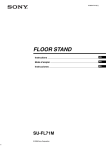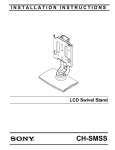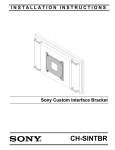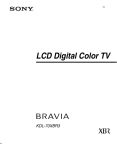Download Operating Instructions - Manuals, Specs & Warranty
Transcript
4-000-704-11(2)
LCD Digital Color TV
Operating Instructions
KDL-40SL140
KDL-46SL140
© 2008 Sony Corporation
Owner’s Record
The model and serial numbers are located at
the rear of the TV. Record these numbers in
the spaces provided below. Refer to them
whenever you call upon your Sony dealer
regarding this TV.
Model Name
Safety
s
s
s
s
Serial No.
s
CAUTION
To prevent electric shock, do not use this
polarized AC plug with an extension cord,
receptacle or other outlet unless the blades can
be fully inserted to prevent blade exposure.
s
s
Declaration of Conformity
Trade Name: SONY
Model: KDL-40SL140/KDL-46SL140
Responsible Party: Sony Electronics Inc.
Address: 16530 Via Esprillo
San Diego, CA 92127 U.S.A.
Telephone Number: 858-942-2230
This device complies with part 15 of the FCC
rules. Operation is subject to the following two
conditions: (1) This device may not cause
harmful interference, and (2) this device must
accept any interference received, including
interference that may cause undesired operation.
Installing
s
s
s
s
s
NOTIFICATION
This equipment has been tested and found to
comply with the limits for a Class B digital
device, pursuant to Part 15 of the FCC Rules.
These limits are designed to provide reasonable
protection against harmful interference in a
residential installation. This equipment generates,
uses and can radiate radio frequency energy and,
if not installed and used in accordance with the
instructions, may cause harmful interference to
radio communications. However, there is no
guarantee that interference will not occur in a
particular installation. If this equipment does
cause harmful interference to radio or television
reception, which can be determined by turning the
equipment off and on, the user is encouraged to
try to correct the interference by one or more of
the following measures:
s
s
s
s
Reorient or relocate the receiving antenna.
Increase the separation between the
equipment and receiver.
Connect the equipment into an outlet on a
circuit different from that to which the
receiver is connected.
Consult the dealer or an experienced
radio/TV technician for help.
Pursuant to FCC regulations, you are
cautioned that any changes or modifications
not expressly approved in this manual could
void your authority to operate this
equipment.
2
Operate the TV only on 120 V AC.
Use the AC power cord specified by Sony
and suitable for the voltage where you use it.
The plug is designed, for safety purposes,
to fit into the wall outlet only one way. If
you are unable to insert the plug fully into
the outlet, contact your dealer.
If any liquid or solid object should fall
inside the cabinet, unplug the TV
immediately and have it checked by
qualified service personnel before
operating it further.
If you will not be using the TV for several
days, disconnect the power by pulling the
plug itself. Never pull on the cord.
When disconnecting AC power cord, the
power cord should be easily accessible for
disconnection.
For details concerning safety precautions,
see “Safety and Regulatory Booklet”.
s
The TV should be installed near an easily
accessible power outlet.
To prevent internal heat buildup, do not
block the ventilation openings.
Do not install the TV in a hot or humid
place, or in a place subject to excessive
dust or mechanical vibration.
Avoid operating the TV at temperatures
below 41°F (5°C).
If the TV is transported directly from a
cold to a warm location, or if the room
temperature changes suddenly, the picture
may be blurred or show poor color due to
moisture condensation. In this case,
please wait a few hours to let the moisture
evaporate before turning on the TV.
To obtain the best picture, do not expose
the screen to direct illumination or direct
sunlight. It is recommended to use spot
lighting directed down from the ceiling or
to cover the windows that face the screen
with opaque drapery. It is desirable to
install the TV in a room where the floor
and walls are not of a reflective material.
CAUTION
Use the following Sony TVs only with the
following WALL-MOUNT BRACKET or
TV-stand.
Sony TV Model No.
KDL-40SL140
KDL-46SL140
Sony Wall-Mount
Bracket Model
No.
Sony TV Stand
Model No.
Sony Floor Stand
Model No.
SU-WL500
SU-FL300M
SU-FL300L
SU-FL71M
Use with other WALL-MOUNT BRACKET or
TV-stand may cause instability and possibly
result in injury.
To Customers
Sufficient expertise is required for installing the
specified TV. Be sure to subcontract the
installation to Sony dealer or licensed
contractors and pay adequate attention to safety
during the installation.
Note
This television includes a QAM demodulator
which should allow you to receive unscrambled
digital cable television programming via
subscription service to a cable service provider.
Availability of digital cable television
programming in your area depends on the type
of programming and signal provided by your
cable service provider.
For Customers in Canada
This Class B digital apparatus complies with
Canadian ICES-003.
For Customers in the United
States
Lamp in this product contains
mercury. Disposal of these
materials may be regulated due to
environmental considerations. For
disposal or recycling information,
please contact your local authorities
or the Electronic Industries
Alliance (www.eiae.org).
Licensing Information
Macintosh is a trademark licensed to Apple,
Inc., registered in the U.S.A. and other countries.
Manufactured under license from Dolby
Laboratories. “Dolby” and the double-D symbol
are trademarks of Dolby Laboratories.
This TV incorporates High-Definition
Multimedia Interface (HDMI™) technology.
HDMI, the HDMI logo and High-Definition
Multimedia Interface are trademarks or
registered trademarks of HDMI Licensing, LLC.
TruSurround XT, SRS and ( ) symbol are
trademarks of SRS Labs, Inc. TruSurround XT
technology is incorporated under license from
SRS Labs, Inc.
Fergason Patent Properties, LLC:
U.S. Patent No. 5, 717, 422
U.S. Patent No. 6, 816, 141
Blu-ray is a trademark.
“BRAVIA” and
, BRAVIA Theatre
Sync and
are trademarks or registered marks
of Sony Corporation.
“PLAYSTATION” is a registered trademark
and “PS3” is a trademark of Sony Computer
Entertainment Inc.
Contents
Welcome to the World of BRAVIA®
The Four Steps to Stunning HD Experience:
Set, Sound, Source, and Setup ................ 4
Picture Quality and Aspect Ratio .................. 4
Getting Started
1. Installing the TV ......................................... 5
How to Carry the TV .................................... 5
How to Attach the Table-Top Stand ............ 5
Securing the TV ........................................... 6
Bundling the Connecting Cables ................. 8
Preparation for Wall-Mounting ..................... 8
Installing the Wall-Mount Bracket ................ 9
When Installing the TV Against a Wall or
Enclosed Area .................................... 11
2. Locating Inputs and Outputs .................. 12
3. Connecting the TV ................................... 14
Cable System and/or VHF/UHF ................ 14
HD Cable Box/HD Satellite Box ................. 14
PC .............................................................. 16
Other Equipment ....................................... 17
4. Setting Up the Channel List Initial Setup ............................................. 18
Exploring Fun Features
Using BRAVIA Theatre Sync™ with
Control for HDMI...................................... 19
Remote Control
and TV Controls/Indicators
Inserting Batteries ........................................ 20
When Using the Remote Control................. 20
Remote Control ............................................. 21
TV Controls/Indicators ................................. 25
Using TV Menus
Navigating through TV Menus ..................... 27
Menu Descriptions........................................ 27
Using the Shortcuts Menu .................... 28
Using the Picture Menu ........................ 30
Using the Sound Menu ......................... 31
Using the Screen Menu ........................ 32
Using the Channel Menu ...................... 34
Using the Parental Lock ....................... 35
Using the Setup Menu .......................... 38
Other Information
Troubleshooting............................................ 41
Specifications................................................ 44
Index............................................................... 45
Quick Setup Guide (separate volume)
Provides a variety of optional equipment
connection diagrams.
Customer Support
United States http://www.sony.com/tvsupport
Canada http://www.sony.ca/support
On-line Registration
United States http://productregistration.sony.com
Canada http://www.sonystyle.ca/registration
3
Welcome to the World of BRAVIA®
Thank you for purchasing this Sony BRAVIA® high-definition television. The quality of the image you see on
your BRAVIA TV is only as good as the quality of the signal it receives. To experience the stunning detail of
your new BRAVIA TV, you need access to HD programming. Your BRAVIA TV can receive and display HD
programming from:
•
•
•
•
Over-the-air broadcasting via HD-quality antenna
HD cable subscription
HD satellite subscription
Blu-ray Disc™ player or other external equipment
Contact your cable or satellite provider for information on upgrading to HD programming.
To learn more about HDTV, visit:
U.S.A http://www.sony.com/HDTV
Canada http://www.sonystyle.ca/hd
The Four Steps to Stunning HD Experience: Set, Sound, Source,
and Setup
Along with your BRAVIA TV set, a complete HD system requires an HD sound system, a source of HD
programming and proper setup connections. This manual explains basic setup connections (see page 14).
The Quick Setup Guide, enclosed separately, illustrates how to connect other optional equipment.
Picture Quality and Aspect Ratio
You can enjoy crisp, clear images, smooth movement and high-impact visuals from 1080p HD signals. When
you compare a high-definition signal to a standard analog signal, you will notice a big difference. The 1080p
HD signals provide more than twice the vertical resolution of the standard TV signal.
High-definition and standard-definition signals are transmitted with different aspect ratios (the width-to-height
ratio of the image). HDTV uses a wider screen than conventional standard-definition TV.
16:9 (high-definition) source
Most HDTV signals use a wide screen aspect ratio of
16:9. The 16:9 fills your BRAVIA screen, maintaining a
crisp, clear, vivid picture.
4:3 (standard-definition) source
Most standard-definition signals use a boxy 4:3 aspect
ratio. When a 4:3 image is displayed on an HDTV, you
will see black bars on the sides. The picture quality may
not be as sharp as with HD sources.
~
• You can use the Wide Mode function of the TV to adjust the 4:3 image to fit the entire screen (see pages 23 and 32).
• This TV supports signals up to 1080p only through HDMI input.
4
Getting Started
Getting Started
1. Installing the TV
How to Carry the TV
How to Attach the Table-Top Stand
Be sure to follow these guidelines to protect your
properties and avoid causing serious injury.
The Table-Top Stand for this product is packaged
separately. Install the TV unit to the Table-Top
Stand before the connection and setup.
• Before carrying the TV, disconnect all cables.
• Carrying the large size TV requires two or more
people.
• When you carry the TV, place your hand as
illustrated and hold it securely. Do not put stress
on the LCD panel.
• When carrying the TV, do not subject it to shocks
or vibration, or excessive force.
1 Take out the Table-Top Stand from the cushion
and the four screws from the accessory bag.
~
• You will find the Table-Top Stand next to the TV unit.
• Keep the screws away from children.
Accessory
bag
Screws
TV Unit
Table-Top Stand
• Place your palm directly underneath.
2 Place the Table-Top Stand onto a level and
stable surface.
(Continued)
5
3 Gently slide the TV unit onto the neck of the
Table-Top Stand and align the screws holes.
Securing the TV
Sony strongly recommends taking
measures to prevent the TV from toppling
over. Unsecured TVs may topple and result
in property damage, serious bodily injury
or even death.
~
• When you carry the TV unit, place your hand as
illustrated on page 5 and hold it securely. Do not put
stress on the LCD panel or the frame around the
screen.
• Be careful to not pinch your hands or the AC
power cord when installing the TV unit onto the
Table-Top Stand.
4 Use the supplied screws to attach the TV unit
to the Table-Top Stand (refer to the “Attaching
the Table-Top Stand” flyer).
Prevent the TV from Toppling
s Secure the TV to a wall and/or stand.
s Do not allow children to play or climb on
furniture and TV sets.
s Avoid placing or hanging items on the TV.
s Never install the TV on:
• slippery, unstable and/or uneven surfaces.
• furniture that can easily be used as steps, such
as a chest of drawers.
s Install the TV where it cannot be pulled,
pushed, or knocked over.
s Route all AC power cords and connecting
cables so that they are not accessible to
children.
Use a Sony TV Stand
Use a Sony specified TV stand (see page 2) and
follow the instruction manual provided with the
Sony TV stand.
If a Sony specified TV stand is not used, consider
the following recommended measures.
Recommended Measures to Secure the TV
1 Secure the stand for the TV.
~
•If you use an electric screwdriver, set the torque for
tightening at approximately 1.5 N·m {15Kgf·cm}.
Make sure the TV stand can adequately support the
weight of the TV. Use two angle braces (not
supplied) to secure the stand.
For each angle brace use the appropriate hardware
to:
• Attach one side of the angle brace to the wall stud.
• Attach the other side to the TV stand.
Angle brace
Stand
6
Use the optional hardware listed below (not
supplied):
• M6 × 10-12 mm anchor bolt (screwed into the
TV’s Table-Top stand).
• A screw or similar (attach it to the TV stand).
• Rope or chain (strong enough to support the
weight of the TV). Make sure that there is no
excess slack in the rope or chain.
An alternative way to secure the TV is with an
optional Sony Support Belt Kit.
Anchor bolt
Screw hole on the
Table-Top stand
Getting Started
2 Secure the TV to the stand.
Wallanchor
~
• Measure 2 provides minimal protection against the TV
toppling over. For further protection, follow all three
measures recommended above.
Screw
~
Contact Sony Customer Support to obtain the optional
Support Belt Kit by providing your TV model name.
• For United States call: 1-800-488-7669 or visit:
www.sony.com/accessories
• For Canada call: 1-877-899-7669
3 Anchor the TV to the Wall.
Use the hardware listed below (not supplied):
• Two M6 × 12-18 mm anchor bolts (screw into
the top-most wall-mount holes located on the
rear of the TV).
• Rope or chain (attach to one M6 anchor bolt).
• Wall-anchor (attach to the wall stud) strong
enough to support the weight of the TV (pass
the rope through the wall-anchor, then attach to
the other M6 anchor bolt).
Anchor bolts
Wall-mount
holes
Rope or
chain
(Continued)
7
Bundling the Connecting Cables
Preparation for Wall-Mounting
You can bundle the connecting cables as illustrated
below.
This TV can be installed on a wall by using a WallMount Bracket (sold separately). Before mounting
the TV on a wall, the Table-Top Stand must be
removed from the TV.
~
• Do not remove the Table-Top Stand for any reason other
than to wall-mount the TV.
• For product protection and safety reasons, Sony
strongly recommends that you use the Wall-Mount
Bracket model designed for your TV and the wallmounting of your TV should be performed by a
Sony dealer or licensed contractor.
Use your TV with the following WALL-MOUNT
BRACKET only.
Sony TV Model No.
KDL-40SL140
KDL-46SL140
Sony Wall-Mount Bracket Model No.
~
• Do not bundle the AC power cord with other connecting
cables.
SU-WL500
• For bracket installation, refer to the instructions on
page 9 and the instruction guide provided by the WallMount Bracket model for your TV. Sufficient expertise
is required for installing this TV, especially to
determine the strength of the wall that will withstand
the TV’s weight.
• Be sure to store the removed screws and Table-Top
Stand in a safe place until you are ready to reattach the
Table-Top Stand. Keep the screws away from
children.
• Be sure to use the screws supplied with the Wall-Mount
Bracket when attaching the mounting hooks to the TV
set.
The supplied screws are designed so that they are 8 mm
to 12 mm in length when measured from the attaching
surface of the mounting hook. The diameter and length
of the screws differ depending on the Wall-Mount
Bracket model. Use of screws other than those supplied
may result in internal damage to the TV set or cause it
to fall, etc.
8-12 mm
Screw (supplied with the Wall-Mount
Bracket)
Mounting Hook
Rear of the TV set
8
Installing the Wall-Mount Bracket
1 Disconnect all the cables from the TV.
2 Remove the four screws from behind the TV as
To Customers
indicated below. Do not remove any other
screws from the TV.
Your KDL-40SL140/KDL-46SL140 can be
wall-mounted using a Wall-Mount Bracket (sold
separately). See table on page 8 showing the WallMount Bracket model appropriate for your TV.
For product protection and safety, Sony strongly
recommends that you use the Wall-Mount
Bracket designed for your TV and wallmounting is performed by a Sony dealer or a
licensed contractor. Do not attempt to install it
yourself. Sony is not liable for any damage or
injury caused by mishandling or improper
installation.
3 Gently lay the TV (face down) onto a level and
stable surface covered with a thick and soft
cloth.
4 Secure the Mounting Hooks to the rear of the
TV. For more details refer to Install the WallMount Bracket and also the instruction guide
provided by the Wall-Mount Bracket model for
your TV.
~
• If an electric screwdriver is used, set the torque to
tighten at approximately 1.5 N·m {15Kgf·cm}.
Please provide your licensed contractor with this
installation information as well as instructions
supplied with the Wall-Mount Bracket.
To Sony Dealers and Licensed Contractors
To avoid injury and property damage, read these
instructions carefully. Periodic inspection and
maintenance is highly recommended to ensure that
TV is securely mounted.
Installing the Wall-Mount Bracket and
Mounting Hooks
1 Open the Wall-Mount Bracket package and
check for all the required parts including the
instruction.
2 See the Installation Dimensions Table on
page 10 to determine the best location for wallmounting. The wall must be strong enough to
support at least four times the weight of the
TV. Also refer to the instruction provided with
your Wall-Mount Bracket.
(Continued)
9
Getting Started
Follow the simple steps below to remove the TableTop Stand:
4 Disconnect all cables and remove the Table-
Installation Dimensions Table
Unit: inches (mm)
TV Model
KDL-40SL140
KDL-46SL140
A
44 1/8 (1,119)
49 3/8 (1,252)
B
24 1/4 (615)
27 1/4 (691)
C
4 7/8 (122)
3 3/8 (84)
D
17 1/4 (438)
17 1/4 (437)
TV dimensions
Screen center
dimensions
Angle (0°)
Length
for each
mounting
angle
E
Angle (20°)
Weight
6
3/
4
(171)
7 (176)
F
14 (354)
G
23 1/8 (587)
26 (659)
H
18 3/4 (476)
18 7/8 (477)
TV
43 lb. (19.5 kg)
57 lb. (25,5 kg)
x4
172 lb. (78 kg)
228 lb. (102 kg)
15 1/4 (385)
Top Stand. See page 8 for details.
5 Install Mounting Hooks on the TV. See Screw
and Hook Locations Diagram below.
Screw and Hook Locations Diagram
TV Model
KDL-40SL140
KDL-46SL140
Screw location Hook location
d, g
b
Screw location
When installing the Mounting Hooks on the TV.
~
• The installation dimensions may differ according to
how the TV is installed.
• The wall must be strong enough to support at least four
times the weight of the TV that you are installing.
Unit: inches (mm)
Hook location
Center line of the screen when installed on the wall
When installing the TV onto Base Bracket.
Wall
TV
3 Install the Base Bracket on the wall. Refer to
the instruction provided with your Wall-Mount
Bracket.
10
* Hook position “a” and “c” cannot be used for the models in the table
above.
Getting Started
When Installing the TV Against a Wall
or Enclosed Area
Make sure that your TV has adequate air
circulation. Allow enough space around the TV as
shown below.
Installed on the wall
11 7/ 8 inches
(30 cm)
4 inches
(10 cm)
4 inches
(10 cm)
4 inches (10 cm)
Leave at least
this much
space around
the set.
Installed with stand
11 7 /8 inches
(30 cm)
2 3 /8 inches
4 inches
(10 cm)
4 inches
(10 cm)
(6 cm)
Leave at least this much space around the set.
Never install the TV set as follows:
Air circulation is blocked.
Wall
Air circulation is blocked.
Wall
~
• Inadequate air circulation can lead to overheating of the
TV and may cause damage to your TV or cause fire.
11
2. Locating Inputs and Outputs
Rear of TV
VIDEO IN
1
COMPONENT IN
3
1
DIGITAL
AUDIO
OUT
IN
PC IN
2
1
(OPTICAL)
1
Y
RGB
S VIDEO
SERVICE
ONLY
3
PB
5
VIDEO
PR
4 AUDIO OUT
L
(MONO)
AUDIO
R
L
L
AUDIO
AUDIO
R AUDIO
R
L
6
AUDIO
R
(1080i/720p/480p/480i)
2
(VAR/FIX)
3
4
7
CABLE / ANTENNA
Side panel
IN
4
2
VIDEO IN
2
VIDEO
L (MONO)
AUDIO
R
12
1
Description
Connects to the S VIDEO output jack of your DVD or other video equipment that has
S VIDEO which provides better picture quality than composite video. The S VIDEO does not
provide sound; you will need to connect the audio cables.
VIDEO IN 1/2/3
VIDEO/
L(MONO)AUDIO-R
2 COMPONENT
IN 1/2 (1080i/
720p/480p/480i)/
L-AUDIO-R
3 PC IN
(RGB/AUDIO)
Connects to the composite video and audio output jacks on your A/V equipment such as a
DVD player or other video equipment. VIDEO IN 2 input is located on the left side panel of
the TV.
Connects to your DVD player’s or digital set-top box’s component video (YPBPR) and audio
(L/R) jacks. Component video provides better picture quality than the S VIDEO or the
composite video connections (1).
Connects to a personal computer’s video output connector using an HD15-HD15 cable
(analog RGB, not supplied).
See “PC Input Signal Reference Chart” on page 16 for the signals that can be displayed.
• For some Apple Macintosh computers, it may be necessary to use an adapter (not supplied). If
this is the case, connect the adapter to the computer before connecting the HD15-HD15 cable.
4 HDMI IN 1/2/3/4 HDMI (High-Definition Multimedia Interface) provides an uncompressed, all-digital
audio/video interface between this TV and any HDMI-equipped A/V equipment. HDMI
R-AUDIO-L
supports enhanced, or high-definition video, plus digital audio.
If the equipment has a DVI jack and not an HDMI jack, connect the DVI jack to any
HDMI IN (with DVI-to-HDMI cable or adapter) jack, and connect the audio jack to the
AUDIO IN (L/R) jacks below the HDMI IN 4.
DVI-to-HDMI cable
DVI-to-HDMI adapter
Audio cable
• Be sure to use only an HDMI cable that bears the HDMI logo.
• When connecting a DVI-equipped PC to an HDMI jack, also connect an Audio cable
between the PC and R-AUDIO-L jack.
• The HDMI input has been fitted to suit A/V equipment such as DVD players for 480i, 480p,
720p, 1080i and 1080p signals. PC generated signals may not be rendered as expected due to
scaling factors. For better PC view, use the PC IN (RGB IN) input. Note that this TV
displays all video input signals in a resolution of 1,920 dots × 1,080 lines.
5 DIGITAL AUDIO Connects to the optical audio input of a digital audio equipment that is PCM compatible.
OUT (OPTICAL)
6 AUDIO OUT
Connects to the left and right audio input jacks of your audio or video equipment. You can use
(VAR/FIX)
these outputs to listen to your TV’s audio through your stereo system.
L-AUDIO-R
7 CABLE/
ANTENNA
• Audio Out level is VARIABLE while Speakers are On, when Speakers control is turn
Off the level in the Audio Out is FIXED (see page 31).
RF input that connects to your cable or VHF/UHF antenna.
• Component video (YPBPR) connection are necessary to view 480i, 480p, 720p and 1080i video formats.
• HDMI input supports signals up to 1080p.
• 1080p format can only be supported through HDMI inputs.
• This TV displays all video input signals in a resolution of 1,920 dots × 1,080 lines.
13
Getting Started
Item
1 VIDEO IN 1
S VIDEO
3. Connecting the TV
Cable System and/or VHF/UHF
Cable or VHF/UHF (or VHF only)
75-ohm coaxial cable
(not supplied)
Rear of TV
CABLE/ANTENNA input
• It is strongly recommended that you connect the antenna/cable input using a 75-ohm coaxial cable (not supplied) to
receive optimum picture quality. A 300-ohm twin lead cable can be easily affected by radio frequency interference,
resulting in signal degradation.
Cable and VHF/UHF (or VHF only)
If you want to watch both cable and antenna (over-the-air) programming, you will need to use an optional
A-B RF Switch (not supplied) to switch between the cable and over-the-air antenna programming, as shown.
A-B RF
Switch
Cable
A
Antenna
B
Rear of TV
CABLE/ANTENNA input
• Be sure to set Cable setting to On or Off in Channel menu for the type of input signal you choose (see page 34 for
more details).
HD Cable Box/HD Satellite Box
You can also enjoy high-definition programming by subscribing to high-definition cable service or highdefinition satellite service. For the best possible picture, connect these components to your TV via the
HDMI or component video (with audio) input on the back of your TV.
Shown with HDMI Connection
HDMI cable
CATV/
Satellite
antenna cable
Rear of TV
VIDEO IN
1
COMPONENT IN
3
1
DIGITAL
AUDIO
OUT
IN
PC IN
2
1
(OPTICAL)
Y
RGB
S VIDEO
3
PB
VIDEO
PR
4 AUDIO OUT
L
(MONO)
AUDIO
R
L
AUDIO
R
(1080i/720p/480p/480i)
HD cable box/HD satellite box
14
L
AUDIO
R AUDIO
L
AUDIO
R
(VAR/FIX)
Getting Started
Shown with DVI Connection
CATV/
Satellite antenna cable
Rear of TV
DVI-to-HDMI cable
VIDEO IN
1
1
DIGITAL
AUDIO
OUT
IN
PC IN
COMPONENT IN
3
2
1
(OPTICAL)
Y
RGB
S VIDEO
HD cable box/HD satellite box
3
PB
VIDEO
PR
4 AUDIO OUT
L
L
(MONO)
L
AUDIO
AUDIO
AUDIO
R AUDIO
L
AUDIO
R
R
R
(1080i/720p/480p/480i)
(VAR/FIX)
AUDIO-L (white)
AUDIO-R (red)
Audio cable
~
• If the equipment has a DVI jack and not an HDMI jack, connect the DVI jack to any HDMI IN (with DVI-to-HDMI
cable or adapter) jack and connect the audio jack to the AUDIO IN (L/R) jacks below the HDMI IN 4. For details, see
page 13.
CATV/
Satellite antenna cable
Shown with Component Connection
HD cable box/HD satellite box
Rear of TV
Y (green)
COMPONENT IN
VIDEO IN
1
3
1
DIGITAL
AUDIO
OUT
IN
PC IN
2
1
(OPTICAL)
Y
PB (blue)
PR (red)
RGB
S VIDEO
3
PB
Component
video cable
VIDEO
PR
4 AUDIO OUT
L
(MONO)
AUDIO
R
L
AUDIO
R
(1080i/720p/480p/480i)
Audio cable
L
AUDIO
R AUDIO
L
AUDIO
R
(VAR/FIX)
AUDIO-L (white)
AUDIO-R (red)
(Continued)
15
PC
Use the TV as a monitor for your PC by connecting an HD15-HD15 cable as shown below. This TV can
also be connected to a PC with a DVI or HDMI output. (Refer to the separate Quick Setup Guide.)
Rear of TV
VIDEO IN
1
COMPONENT IN
3
1
DIGITAL
AUDIO
OUT
IN
PC IN
2
1
(OPTICAL)
Y
RGB
S VIDEO
3
PB
VIDEO
PR
4 AUDIO OUT
L
(MONO)
AUDIO
R
L
L
AUDIO
AUDIO
R AUDIO
R
L
AUDIO
R
(1080i/720p/480p/480i)
(VAR/FIX)
HD15-HD15 cable
(analog RGB)
Audio cable (stereo mini plugs)
~
• Connect the PC IN jack to the PC using an HD15-HD15 cable with ferrite core (analog RGB) and audio cable
(page 13).
• The PC IN does not support 1080p format.
PC Input Signal Reference Chart
After connecting the PC to the TV, set the output signal from the PC according to the chart below.
Signals
VGA
SVGA
XGA
WXGA
Horizontal
(Pixel)
640
640
800
800
1,024
1,024
1,024
1,280
1,360
Resolution
×
Vertical
(Line)
×
×
×
×
×
×
×
×
×
480
480
600
600
768
768
768
768
768
Horizontal
frequency (kHz)
Vertical
frequency (Hz)
31.5
37.5
37.9
46.9
48.4
56.5
60.0
47.8
47.7
60
75
60
75
60
70
75
60
60
Standard
VGA
VESA
VESA Guidelines
VESA
VESA Guidelines
VESA
VESA
VESA
VESA
~
• This TV’s PC input does not support Sync on Green or Composite Sync.
• This TV’s PC VGA input does not support interlaced signals.
• For the best picture quality, it is recommended to use the signals (boldfaced) in the above chart with a 60 Hz vertical
frequency from a personal computer. In plug and play, signals with a 60 Hz vertical frequency will be detected
automatically. (PC reboot may be necessary.)
• 1080p format can only be supported through HDMI inputs.
16
Getting Started
Other Equipment
Blu-ray
Disc Player/
“PS3”
Personal
computer
DVD
player
Digital
satellite
receiver
Audio
Digital
cable box system
Side Panel
IN
2
VIDEO IN
2
VIDEO
L (MONO)
AUDIO
Rear of TV
R
VIDEO IN
1
COMPONENT IN
3
1
DIGITAL
AUDIO
OUT
IN
PC IN
2
1
(OPTICAL)
Y
RGB
3
S VIDEO
PB
VIDEO
4
AUDIO OUT
PR
L
(MONO)
AUDIO
R
L
AUDIO
R
(1080i/720p/480p/480i)
L
AUDIO
R AUDIO
L
AUDIO
R
(VAR/FIX)
CABLE / ANTENNA
CABLE/ANTENNA
VCR
Game
system
Digital
recorder
Analog audio
Digital audio
equipment
equipment
(A/V Receiver/
Home Theater)
Camcorder
~
• Refer to the Quick Setup Guide (supplied) when connecting other equipment to your TV.
17
4. Setting Up the Channel List Initial Setup
After you finish connecting your TV, you need to
run Initial Setup, which automatically sets up
available channels. The Initial Setup screen
appears when you turn on your TV for the first
time. If you do not want to set up the channels at
this time, you can do it later by selecting the Auto
Program option in the Channel menu (see page
34).
1 Press
POWER
to turn on the TV.
The Initial Setup screen appears.
Initial Setup
Press
to choose a language.
Please select your language:
2 Press V/v to highlight the desired language,
then press
.
3 Connect cable or antenna, then select Yes to
run Auto Program.
~
• If you want to run Auto Program at a later time,
select No.
• If you have cable and antenna available, please
connect cable first.
• IMPORTANT: You must perform Auto Program
after the cable or antenna is connected. If you
cancel Auto Program before completion some
channels may not be available.
4 Follow the help text provided on the screen to
run Auto Program. The Auto Program will
scan for available channels from the signal
source directly connected to the TV’s
CABLE/ANTENNA input.
5 When the Auto Program is complete, select
OK to finish the Auto Program process.
18
To run Auto Program at a later time
❑
Use the Auto Program feature at Channel
menu as described on page 34.
To display the picture in your preferred
aspect ratio
❑
Select the proper Wide Mode as described on
pages 23 and 32.
~
• You may want to set up convenient features such as
Favorites (see page 28, 34), Show/Hide Channels
(see page 34), Label Channels (see page 34) when
Auto Program is completed.
Exploring Fun Features
Using BRAVIA Theatre Sync™
with Control for HDMI
When connecting a Sony A/V receiver with the
BRAVIA Theatre Sync function to your TV, the
following operation is possible:
This TV is equipped with BRAVIA Theatre
Sync™. The Control for HDMI function enables
BRAVIA Theatre Sync to allow communication
between Sony TV’s and Sony equipment. Only
Sony equipment with Control for HDMI
capability is supported.
• Pressing
on the remote control turns on and
searches for an external audio system that supports
BRAVIA Theatre Sync. When the Theatre Sync audio
system is on, the internal speakers of the TV will turn
off and the Picture Mode will change automatically
to Cinema.
To connect Sony equipment with Control
for HDMI
Use an HDMI cable that bears the HDMI logo for
connection. See pages 14 to 17 or see the HDMI
connection shown in the Quick Setup Guide
provided with the TV documentation.
• When using BRAVIA Theatre Sync or other BRAVIA
Sync features, the included remote control will change
some of the buttons functions to accommodate control
over the device. If the device does not support this
feature, some buttons will remain without function.
Setting the Control for HDMI
In order for the function of Control for HDMI to
operate, the TV and other Sony equipment with
Control for HDMI function must be setup (see
page 39). For other equipment, refer to the
operating instruction for that equipment.
Control for HDMI available with your TV
The following operations are available after you
connect the Sony equipment with Control for
HDMI function to your TV:
• Automatically turn off the connected equipment when
you turn off the TV.
• The TV will automatically turn on and tunes to the
respective HDMI input when the connected equipment
is turned on by One-Touch-Play.
• Equipment listed under External Inputs will turn on
automatically when selected.
19
Remote Control
and TV Controls/Indicators
Inserting Batteries
Insert two size AA batteries (supplied) by matching
e and E on the batteries to the diagram inside the
battery compartment of the remote control.
Push to open
When Using the Remote Control
Follow the guidelines below
• Point your remote control directly at the IR sensor
located on your TV.
• Make sure that no objects are blocking the path
between the remote control and IR sensor on your
TV.
• Fluorescent lamps can interfere with your remote
control; try turning off the fluorescent lamps.
• If you are having troubles with the remote control,
reinsert or replace your batteries and make sure
that they are correctly inserted.
20
Remote Control
SOUND
Description
1 DISPLAY
Press once to display the information pertaining to the
channel and/or program when available. The OSD (On
Screen Display) will time out in a few seconds or press again
to immediately turn off the display.
2 SLEEP
Press repeatedly until the TV displays the time in minutes
(Off, 15, 30, 60 or 120 minutes) that you want the TV to
remain on before shutting off. To cancel Sleep Timer, press
repeatedly until Off appears.
3 THEATER
Press to turn on and off the Theater Mode. The picture
settings will be set for a cinema-like experience and the
audio will be switched to the audio output of the attached
speakers of your BRAVIA Theatre Sync audio system. Your
BRAVIA Theatre Sync audio system must be connected by
an HDMI connection to your TV (see page 14 for details).
4 SOUND
Press repeatedly to step through the Sound Mode settings:
Dynamic, Standard, Game, Clear Voice, Custom.
These Sound Mode settings can be also accessed in the
Sound menu (see page 31).
5 PICTURE
Press repeatedly to cycle through the available picture
modes: Vivid, Standard, Cinema. The picture modes can
also be accessed in the Picture menu. For details, see page
30.
GUIDE
TOOLS
MENU
• The 5 and CH + buttons have a tactile dot. Use them as a reference when
operating the TV.
(Continued)
21
Remote Control and TV Controls/Indicators
1
2
3
4
5
Button
Button
qf 6 GUIDE
Description
Press to display the Guide when you are watching channels
(if it is available from the station).
Using the Guide
SOUND
6
The Guide allows you to select the channels from a channel
list and also provides information about the current program
being shown on each channel.
GUIDE
Make Way for Ducks!
15.1
KPBS-HD
(0:29 Remaining)
Series follows the aquatic misadventures of Henry and Riley, two wayward ducks on a unique mission.
Info
banner
TV-G
1080i HD
16:9
Full
12:00 AM
2
7
8
TOOLS
MENU
Channel
list
9
q;
qa
7 RETURN
qs
qd
6
FOX6
10
XWV-10
12
XEW-12
15
KPBS
15.1
KPBS-HD
15.2
V-me
21
AZ-21
27
AZT-27
33
TEL-33
39
NBC-39
40.1
FR-40
41
CH-41
• Program information in the guide is provided by the
broadcasters. As a result, it may sometimes include only
the channel number, without a program title or
description.
Press to go back to the previous screen or exit from the
screen when displaying menu items and settings.
8 MENU
Press to display the menu with TV functions and settings.
See “Using TV Menus” on page 27.
9 CC
Press to turn on and off the Closed Captions (CC). To
change or customize the CC display, see page 38.
0 0-9/ENT
Press
to select a channel; the channel changes after
few seconds. Press
to change channels immediately.
qa
Use with
and
to select digital channels. For
example, to enter 2.1, press
,
, 1 and
.
qs VOL +/–
Press to adjust the volume.
qd MUTING
Press to mute the sound. Press again or press VOL + to
restore the sound.
Press to turn on and off the TV.
qf POWER
22
3
ON-3
Description
qg WIDE
Press repeatedly to step through the Wide Mode settings:
Wide Zoom, Normal, Full, Zoom. The Wide Mode
settings can be also accessed in the Screen menu
(see page 32).
Changing the Wide Screen Mode
4:3 Original source
Standard-definition source
16:9 Original source
High-definition source
m
Wide Zoom
m
Wide Zoom
Normal
Normal
TOOLS
MENU
This mode is not available
Full
Full
Zoom
Zoom
~
• Normal is available with 480i or 480p sources only.
• Full Pixel is only available with 1080p source.
Changing the Wide Screen Mode for PC
Timing
Incoming PC signal
Incoming PC signal
800 × 600
1,280 × 768
m
Wide Zoom
m
Wide Zoom
Normal
Normal
Full
Full
Zoom
Zoom
(Continued)
23
Remote Control and TV Controls/Indicators
qg
SOUND
GUIDE
Button
Button
Description
qh INPUT
Press to display the list of External Inputs and TV mode.
Press repeatedly to toggle through the inputs.
SOUND
GUIDE
TOOLS
qh
qj V/v/B/b
qj
qk TOOLS
qk
MENU
ql
w;
ql JUMP
w; FAVORITES
wa
wa CH +/–
24
• See page 38 (Label Inputs) on setting up the External
Inputs labels.
Press V/v/B/b to move the on-screen cursor. Press
to
select/confirm an item.
This button supports different functions depending on the
condition. When PC input is active, press
to view a
channel at the same time as a PIP (picture in picture) screen
(see page 29 for details). When antenna input is active and
the broadcast includes Regional Digital Ratings, press
to
view the list of special ratings. When an HDMI controlled
equipment is active, press
to access the equipment menu,
if the equipment supports the function.
Press to alternate between two channels. The TV will
alternate between the current channel and the last channel
tuned with the buttons
and
on the remote control.
This feature lets you create and choose a list of up to eight
favorite channels or inputs.
Press V/v to select the option Add to Favorites, and press
to add the current channel or input to your Favorites
list.
• Your Favorites list will be cleared each time you run
Auto Program (see pages 18 and 34).
Press to scan through channels. To scan quickly through
channels, press and hold down either +/–.
TV Controls/Indicators
Remote Control and TV Controls/Indicators
MENU
Item
Description
1 MENU
Press to display the menu with TV functions and settings (see “Using TV Menus” on
page 27).
Press to display the External Inputs list, toggle through the list and select your desired
input.
In the menu screen, this button serves as confirming the selection or setting.
Press to adjust the volume. In the menu screen, these buttons serve as left/right buttons.
2
INPUT
3
– VOLUME +
Press to scan through channels. In the menu screen, these buttons serve as up/down buttons.
– CHANNEL +
Press to turn on and off the TV.
5 POWER
6 PIC OFF/TIMER Lights up in amber when the Timer or Sleep functions are set. When the timer is set, this
LED will remain lit even if the TV is turned off. For details, see page 39. If the LED blinks in
LED
red continuously, this may indicate the TV needs servicing (see contacting Sony information
on the back cover).
Lights up in green when the Backlight feature is activated (see page 31).
STANDBY
LED
Light up in red when your TV is in PC standby mode.
7
Lights up in green when the TV is turned on.
8 POWER LED
4
9 (IR) Infrared
Receiver
Light Sensor
Receives IR signals from the remote control.
Senses room light level and adjusts the screen brightness accordingly (see page 30 for details).
Do not put anything near the sensor, as its function may be affected.
• Make sure that the TV is turned off before unplugging the power cord. Unplugging the power cord while the TV is
turned on may cause the POWER LED to remain lit for up to 20 seconds or may cause the TV to malfunction.
25
Using TV Menus
MENU provides one button access for controlling your TV. It enables you to perform a variety of tasks
intuitively with a control panel on the screen.
Navigating through TV Menus
GUIDE
Press
on the remote control to display the menu options.
To highlight a menu option press B, then press V/v to go through the menus.
To select an option press
or b.
Press V/v to select or adjust your desired option, then press
To exit press
Using TV Menus
1
2
3
4
5
SOUND
.
.
TOOLS
• The buttons (V/v/B/b
Theatre Sync mode.
MENU
) can be used to control other devices in BRAVIA
Menu Descriptions
Shortcuts
Picture
Sound
Screen
The Shortcuts menu lets you select the
The Channel menu is used to provide
External Inputs and Favorites list. It
maintenance to the channel options.
also allows quick access to Wide
Select from: Favorites, Cable, Add
Mode, Clock/Timers, Parental
Digital Channels, Auto Program,
Channel
Lock, Closed Captions (CC), Cable
Show/Hide Channels, Label
and PC-PIP functions.
Channels or Diagnostics.
The Picture menu is used to fine tune
The Parental Lock feature allows you
the image quality and allows you to
to set up the TV to block programs
customize several parameters for
according to their content and rating
optimal viewing. Select from: Picture Parental Lock levels; use
on the remote control
Mode, Backlight, Picture,
to enter a four-digit password. The first
Brightness, Color, Hue, Color
time you create a password, confirm the
Temp (Color Temperature),
password by entering it again.
Sharpness, Advanced Settings or
Reset.
The Setup menu provides you additional
The Sound menu allows you to fine
features like: Closed Captions (CC),
tune and change audio. Select from:
Info Banner, Label Inputs, Skip
Sound Mode, Effect, Steady
Inputs, Clock/Timers, Language,
Sound, Treble, Bass, Balance,
Setup
Volume Offset, Speakers,
Auto Sort Control, Control for HDMI,
Backlight or Alternate Audio/MTS.
Update Control for HDMI List or
Product Support.
The Screen menu allows you to change
the proportions of the screen. Select
from: Wide Mode, Auto Wide, 4:3
Default, Vertical Center, Vertical
Size or Phase.
(Continued)
27
Using the Shortcuts Menu
External Inputs
This feature lets you select the external inputs connected to your TV.
Press V/v to choose an external input from the list of eleven inputs.
To select press
.
1
2
• To exit from external inputs list, press MENU .
• To change external inputs again, repeat steps 1-2.
• To go back to channels, press CH +/– to go through the channels or repeat steps 1-2 and
select TV; or press FAVORITES to select a channel from your Favorites list.
• You can also access the External Inputs list directly by pressing
without having to
navigate through the Menu.
This feature lets you create and choose a list of up to eight favorite channels or inputs.
Press V/v to select the option Add to Favorites and press
to add the current channel or
input to your Favorites list.
INPUT
Favorites
Wide Mode
• You can also press FAVORITES to see your Favorites list.
This option is a direct shortcut to the Screen menu to adjust the picture size in the Wide
Mode option (see page 32).
• Wide Mode can also be accessed by pressing
on the remote control.
• See WIDE button description on page 23 for accessing the Wide Mode.
Clock/Timers
This option is a shortcut to adjust Clock/Timers on Setup menu (see page 39).
Parental Lock
This option is a shortcut to the Parental Lock menu which allows you to enter a password
to block channels (see page 35).
Closed Captions (CC) This option is a shortcut to Closed Captions (CC) screen on Setup menu (see page 38).
Cable
This option is a shortcut to adjust Cable settings on Channel menu (see page 34).
28
PC-PIP
The PIP (Picture In Picture) feature allows you to view two pictures simultaneously on the
TV by displaying the PC input signal in the Main Window and a TV channel in the Sub
Window.
Main Window
(PC)
Sub Window
(TV Channel)
To change channels in the Sub Window
Press CH +/– to change the channels or enter the channel number using the
buttons.
-
numeric
To Exit from PC-PIP (PC input)
Press MENU and select External Inputs on the Shortcuts menu.
From External Inputs list, select TV input to return to TV Channels.
1
2
• To exit from PC-PIP, you can also select a channel from your Favorites channels list on
the Shortcuts menu.
• When the PC input signal is selected with the Sub Window active, you can only see TV
channels; other external inputs are not available for this view (like VCR/DVD).
• Closed Captions (CC) is not available in the Sub Window.
• Parental Lock feature will work in the Sub Window, a padlock will appear on the
blocked channels.
• When Auto Sort Control is set to On the last item selected within this menu will be listed at the top of the
Shortcuts menu list (see page 39).
(Continued)
29
Using TV Menus
• You need a PC input signal to use PC-PIP function.
• PIP window is only supported for the PC resolutions described on the PC Input Signal
Reference Chart (page 16).
• To turn on or off the Sub Window on the screen press
from the remote control while
using the PC input.
• You can also select PC input from the External Inputs list. Press MENU , select
External Inputs, then select PC input from the list.
Using the Picture Menu
Picture Mode
For Video
Vivid
Standard
Cinema
For PC Timings
Text
Video
Game
Backlight
Picture
Brightness
Color
Hue
Color Temp (Color
Temperature)
White Adjustment
Sharpness
Advanced Settings
Reset
30
For enhanced picture contrast and sharpness.
For standard picture settings. Recommended for home entertainment.
For viewing film-based content. Most suitable for viewing in a theaterlike environment.
This option is available for PC timing (HDMI or PC input) signal to
enhance the text shown on the screen.
This option is available for PC timing (HDMI or PC input) signal to
enhance the video shown on the screen.
This option is available for PC timing (HDMI or PC input) signal to
enhance the game shown on the screen.
• Picture Mode for all inputs can also be accessed by pressing
on the remote
control to directly toggle the modes.
• The options for Picture Mode may vary depending on the input.
Press B/b to brighten or darken the backlight, then press
to set.
Press B/b to increase or decrease picture contrast, then press
to set.
Press B/b to brighten or darken the picture, then press
to set.
Press B/b to increase or decrease color intensity, then press
to set.
Press B/b to increase or decrease the green or red tones, then press
to set.
Cool
Gives the white colors a bluish tint.
Neutral
Gives the white colors a neutral tint.
Warm 1, 2
Gives the white colors a reddish tint.
Press B/b to sharpen or soften the picture, then press
to set.
Noise
Reduces the noise level of connected equipment, and the
Reduction
CABLE/ANTENNA input.
Advanced C.E. Automatically optimizes the backlight and contrast. This setting is
(Advanced
especially effective for dark picture scenes.
Contrast
Enhancer)
Gamma
Adjusts the balance between the light and dark areas of the picture.
Clear White
Emphasizes white and light colors.
Live Color
Makes colors more vivid and reproduces clear skin tones.
Light Sensor
Select On to enable the automatic picture (screen) brightness control.
The light sensor measures the room brightness which allows the TV to
automatically adjust the backlight brightness based on the picture
settings and the ambient room light conditions.
• Be sure not to put anything around the sensor, as its function may be
affected.
• In low light the range of the backlight control is reduced when Light
Sensor is set to On.
Resets the current Picture Mode setting to factory default values.
Using the Sound Menu
Sound Mode
Steady Sound
Treble
Bass
Balance
Volume Offset
Speakers
Backlight
Alt. Audio/MTS
Alternate Audio/MTS
Enhances the sound of action movies, sports events and musical
videos.
Standard
Standard sound optimized for home use.
Game
Enhances the video games sound.
Clear Voice
Enhances the voice sound; recommended for television news and
documentary programs.
Custom
Allows you to customize Treble and Bass sound settings.
Off
Turns off TruSourround XT effect.
TruSurround XT Produces realistic surround sound experience.
On
Stabilizes the volume across all programs and commercials.
Off
Turns off Steady Sound.
Press B/b to increase or decrease higher-pitched sounds, then press
to set.
Press B/b to increase or decrease lower-pitched sounds, then press
to set.
Press B/b to emphasize left or right speaker balance, then press
to set.
Adjusts the volume level of the current input (TV or video input) relative to other inputs.
Select to turn on or off the internal speakers.
Using TV Menus
Effect
Dynamic
• Audio Out level is VARIABLE while Speakers are On, when Speakers control is turn
Off the level in the Audio Out is FIXED.
On
The Backlight is turned on.
Off
Turns off the Backlight to reduce the power consumption while the
audio is left on.
This Audio feature for current program lets you select an alternate audio (if it is available).
• Alternate audio is disabled for analog signals and for digital signals that do not have
audio streams.
Mono
Select for mono reception. Use to reduce noise during weak stereo
broadcasts.
Stereo
Select for stereo reception when viewing a program broadcast in
stereo.
Auto SAP
Select to automatically switch the TV to second audio programs when
a signal is received. If no SAP signal is present, the TV remains in
Stereo mode.
• MTS is available only for analog programs.
• To customize Treble and Bass sound settings, you must select Custom on Sound Mode.
(Continued)
31
Using the Screen Menu
Wide Mode
These options allow you to change the proportion of the screen.
Wide Zoom
Fills the screen with minimum distortion.
Normal
Select to display 4:3 pictures in original aspect ratio when the original
source is 4:3.
• Normal is available with 480i or 480p sources only.
• Normal is replaced by Full Pixel when you are watching 1080p source.
Full
Select to enlarge the picture horizontally to fill the screen when the
original source is 4:3 (standard-definition source). When the original
source is 16:9 (high-definition source), select this mode to display 16:9
picture in original size.
Zoom
Select to enlarge the original picture horizontally and vertically to fill
the screen while maintaining the aspect ratio.
Full Pixel
Displays the picture for 1080p sources in its original size.
Auto Wide
4:3 Default
Vertical Center
Vertical Size
Phase
• Wide Mode can also be accessed by pressing
on the remote control.
• See WIDE button description on page 23 for accessing the Wide Mode.
On
Select to have the screen automatically change to the screen mode
based upon program’s content. Typically this requires special setup on
the DVD equipment’s menu. If frequent screen changes are disturbing
to you, select Off.
Off
Select to turn off the Auto Wide option.
Choose a screen mode from the Wide Mode option.
Select the default Screen Mode to use for 4:3 sources.
Wide Zoom
Select to enlarge the 4:3 picture to fill the 16:9 screen, keeping the
original image as much as possible, with minimal distortion.
Normal
Select to display the 4:3 picture in its original size.
Full
Select to enlarge the picture horizontally to fill the screen when the
original source is 4:3 (standard-definition source).
Zoom
Select to enlarge the original picture without distorting the aspect ratio.
Off
To turn Off automatic size for 4:3.
• If 4:3 Default is set to anything but Off, the Wide Mode setting applies only to the
current channel. When you change channels (or inputs), Wide Mode is automatically
replaced with the 4:3 Default setting for 4:3 sources. To retain the current Wide Mode
setting as channels and inputs are changed, set 4:3 Default to Off.
Allows you to move the position of the picture up and down.
Allows you to adjust the vertical size of the picture.
Adjusts to fine tune overall sharpness.
• Phase is disabled when the TV is receiving a different video input than PC.
32
Screen settings for PC timings and HDMI-PC (PC input) differ from all other input modes and are shown below.
Wide Mode
Wide Zoom
Normal
Full
Zoom
Fills the screen with minimum distortion.
Select to display the picture in its original resolution and aspect ratio.
Select to enlarge the picture to fill the screen.
Select to enlarge the picture to fill the screen, while maintaining its
original aspect ratio.
Using TV Menus
• Wide Mode can also be accessed by pressing
on the remote control.
• See WIDE button description on page 23 for accessing the Wide Mode.
(Continued)
33
Using the Channel Menu
Favorites
Lets you set up a list of up to eight of your favorite channels or inputs.
Press V/v to select the Add to Favorites option and press
to add the current channel or
input to your Favorites list.
To select a favorite channel or input from the list, press V/v to go through the list and
to
select.
• To exit press MENU .
• To quickly access the Favorites list, press
when there is no menu on the screen.
Cable
On
Select if you are receiving cable channels via cable TV provider.
Off
Select if you are using an antenna.
Add Digital Channels Select to add digital channels without replacing the original channel list. Be sure to set Cable
setting to On or Off in Channel menu for the correct type of input signal you choose.
Auto Program
Automatically sets up the channel list on the TV for all receivable channels (Digital and
Analog).
FAVORITES
• Before starting Auto Program, be sure to select On or Off for the Cable option under
the Channel menu. When it is On, the TV will search for cable channels; when it is Off,
the TV will search for over-the-air signals with an antenna connection.
• If you are using an A-B RF switch (not supplied) to switch between cable or antenna
connection, be sure to select the correct Cable option to On or Off in the Channel Menu.
1 Select Auto Program.
2 Select OK to start Auto Program. When Auto Program is done, select OK.
~
• IMPORTANT: You must perform Auto Program after cable or antenna is
connected. If you cancel Auto Program before completion, some channels may not
be available.
Show/Hide Channels Allows you to show or hide channels that appear when you use the CH +/– button.
1 Press V/v to scroll through the channels until you find the channel you want to show or
hide.
2 Press to determine if the channel will be shown or hidden.
Label Channels
Diagnostics
34
• To show or hide more channels, repeat steps 1-2.
Allows you to assign labels to channel numbers.
1 Press V/v to scroll through the channel numbers. Then press to select the channel
number that you want to assign a label.
2 Press B/b/V/v to move through the label characters (A-Z, 0-9) and press to select
it. To move to the next character press B/b/V/v. Repeat to add up to 7 characters to the
label. Then select
on screen to set it. To assign labels to more channels, repeat
steps 1-2.
• To delete a character select
on screen.
• To have a space between characters select
on screen.
• To exit press
.
Allows to confirm the current signal performance.
Using the Parental Lock
The Parental Lock feature allows you to block programs according to their content and rating levels and
block channels (regardless of the programs). Password is necessary in setting up blocking. Use - on
the remote control to enter a four digit password. The first time you create a password, confirm the password
by entering it again.
Rating
Off
Turn Parental Lock Off. No programs are blocked from viewing based on
their rating.
Child
Maximum ratings permitted are:
U.S: TV-Y, TV-G, G
Canada: C, TV-Y
Youth
Maximum ratings permitted are:
U.S: TV-PG, PG
Canada: C8+, PG, 8 ans+, TV-PG
Young Adult Maximum ratings permitted are:
U.S: TV-14, PG-13
Canada: 14+, 13 ans+, TV-14
Custom
Select to set ratings manually:
U.S: See page 37 for details.
Canada: See page 37 for details.
• If you are not familiar with the Parental Guideline rating system, you should select
Child, Youth or Young Adult to help simplify the rating selection. To set more specific
ratings, select Custom.
Digital Rating
Off
Select to Digital Rating off. No programs containing digital ratings are
(Available only in U.S.A.
blocked from viewing.
where advanced ratings Custom
Select to customize the Parental Lock with downloadable digital ratings.
exist)
Clear All
Select to clear the downloaded ratings.
Unrated
Allow
Allows programs and movies that are broadcast without a rating.
(Available only when
Block
Blocks all programs and movies that are broadcast without a rating.
Country is set to
U.S.A.)
• If you block unrated TV programs, be aware that the following types of programs may be
blocked: programs broadcast from another country, emergency broadcasts, political
programs, sports, news, public service announcements, religious programs and weather.
(Continued)
35
Using TV Menus
To View Blocked Programs
Press
when tuned to a blocked program, then enter the password. To reactivate the Parental Lock
settings, turn off and on the TV.
Channel Block
Allows you to block channels regardless of program ratings. The password needs to be set up
prior to blocking channels. The blocked channel can only be viewed by entering the correct
password.
To block a channel
Press V/v to go through the channels and press
External Input Block
Change Password
Select Country
36
to Block or Allow channels.
To view a blocked channel
Press
when tuned to a blocked program, then enter the password. To reactive the
Parental Lock settings, turn off and on the TV.
Allows you to block individual video inputs.
Press V/v to scroll through the video inputs and press
to Block or Allow.
Select to change your password.
Use
buttons to select a four digit password; to confirm password enter it again.
• You need your password for any future access into the Parental Lock settings. If you
lose your password, see “Lost Password” on page 43.
U.S.A.
Select to use U.S.A. ratings.
Canada
Select to use Canadian ratings.
Custom Rating System Chart
US Models: Selecting Custom Parental Lock Rating Options
To select custom rating options for the U.S., select U.S.A. in the Select Country setting (see page 36).
Movie Rating
• To ensure maximum blocking capability, set the Age-Based Ratings.
Canadian Models: Selecting Custom Parental Lock Rating Options
To select custom rating options for Canada, select Canada in the Select Country setting (see page 36).
English Rating
French Rating
U.S.A. Rating
C
All children.
C8+
Children 8 years and older.
G
General programming.
PG
Parental guidance.
14+
Viewers 14 and older.
18+
Adult programming.
G
General programming.
8 ans+
Not recommended for young children.
13 ans+
Not recommended for ages under 13.
16 ans+
Not recommended for ages under 16.
18 ans+
Programming restricted to adults.
See TV Rating under U.S.A. above for details.
(Continued)
37
Using TV Menus
G
All children and general audience.
PG
Parental guidance suggested.
PG-13
Parental guidance for children under 13.
R
Restricted viewing, parental guidance is suggested for children under 17.
NC-17 and X
No one 17 or under allowed.
TV Rating
Age-Based Ratings
Block programs by their TV-Y
All children.
rating, content or both
TV-Y7
Directed to children age 7 and older.
TV-G
General audience.
TV-PG
Parental guidance suggested.
TV-14
Parents strongly cautioned.
TV-MA
Mature audience only.
Content-Based Ratings
FV
Fantasy violence.
D
Suggestive dialogue.
L
Strong language.
S
Sexual situations.
V
Violence.
Using the Setup Menu
Closed Captions (CC) Allows you to select from several closed captions modes (for programs that are broadcasted
with closed captioning).
Off
Disables Closed Captions (CC).
On
Enables Closed Captions (CC).
Program
Select to program Closed Captions (CC).
If you select the Program option under Closed Captions, you can change the following
settings:
Basic
Allows you to select basic closed caption options (EIA-608).
CC1, CC2,
Displays a printed version of the dialog or
CC3, CC4
sound effects of a program (should be set to
CC1 for most programs).
Text1, Text2,
Displays network/station information presented
Text3, Text4
using either half of the whole screen (if
available).
Digital CC
Allows you to set digital closed captioning to Basic (digital EIA-608)
or Advanced (digital EIA-708).
Advanced
Allows you to select advanced digital (EIA-708) closed caption
options. Select from the available options.
Advanced
Customize the Closed Captions (CC) displays with Character
Settings
Style, Character Color, Character Size, Character Opacity,
Character Align, Edge Color, Edge Type, Background Color,
Background Opacity or Window Color.
~
cc
Info Banner
Label Inputs
• Closed Captions (CC) can be turned on and off by pressing the
button on the
remote control.
Select On to display the program information such as program title and the remaining time
(if the broadcaster offers this service). The Info Banner displays for a few seconds when
the channel is changed. If you don’t want to display the Info Banner, select Off.
Allows you to identify A/V equipment you connected to the TV, such as a VCR, DVD, etc.
For example, if you have a DVD player connected to the VIDEO 1 input, you can select the
label DVD for the VIDEO 1 input. Then when you press
to change inputs, the label you
assigned to that input appears on screen.
1 Press V/v to highlight the input (from 1 to 9) to which you want to assign a label, then
press
to select it.
2 Press V/v to highlight one of the displayed labels, then press to select it.
You can select from the following labels for each input:
DVD, VCR, Blu-ray, Cable Box, Satellite, DVR, Game, Camcorder or Custom (to
customize, follow the same steps of Label Channels on page 34).
Useful to disable inputs to which no equipment is connected.
INPUT
Skip Inputs
38
Clock/Timers
Sleep
Timer
Set the time in minutes (Off, 15, 30, 60 or 120 minutes) that you
want the TV to remain on before shutting off automatically.
You can use the Timer to tune to a specific channel at a scheduled
time.
Select Off to turn off the Timer (previous settings are saved). Select
On to turn on the Timer (previous settings are saved) or select
Program to set the timer by Time, Duration, Days, Source,
Channel and Volume.
Current Time
• Timer feature will not be available until you set the Current
Time.
Select to set the current time (day, hour, minutes and AM/PM).
1
2
3
Language
Auto Sort Control
Control for HDMI
Update Control for
HDMI List
Product Support
Press
to select Current Time.
Press V/v/B/b to set day, hour, minutes and AM/PM.
Press MENU to exit.
Select the language of your choice for displaying all the on-screen settings: English,
Español (Spanish), Français (French).
Select On to sort the Shortcuts menu and Inputs list, based on the most frequent
selections; select Off if you don’t want to sort.
Allows your TV to communicate with other equipment that supports Control for HDMI
function (see page 19).
Update equipments list connected to the HDMI input.
Sony Contact information is available from this screen for your convenience. This option
also provides specific information such as Model Name, Serial Number and Software
Version. Select OK to reset the TV to factory default values, or Cancel if you do not want to
reset the TV to factory default values.
WARNING: The reset will clear all of your customized settings. Parental Lock password
may be required if it has been created.
39
Using TV Menus
If you select Program, press V/v (change the values) or B/b (move
through the options) to set the hour, minutes, AM/PM, duration, days,
source, channel and volume.
You can also set a channel by pressing
(numeric values) and
(if the channel is digital) on the remote control.
To replace a channel press b on the remote control, then press B to go
back to the channel selection and enter a new channel number.
Other Information
Troubleshooting
If you have additional questions, service needs,
or required technical assistance related to the use
of your Sony TV, please visit our website or call
one of the following numbers:
Condition
No picture
No picture.
http://www.sony.com/tvsupport for US Support
http://www.sony.ca/support for Canadian Support
1-800-222-SONY(7669) for US Support
1-877-899-SONY(7669) for Canadian Support
Explanation/Solution
❑
❑
❑
Cannot receive or select channels. ❑
❑
❑
❑
❑
• IMPORTANT: You must perform Auto Program after cable or
antenna is connected. If you cancel Auto Program before
completion, some channels may not be available.
TV is locked to one channel.
❑
The TV turns off automatically.
❑
No picture from some video
sources.
❑
❑
❑
❑
Poor picture
Double images or ghosts.
Only snow and noise appear on
the screen.
Dotted lines or stripes.
❑
❑
❑
❑
❑
❑
Perform the Auto Program to add available channels that are not presently in
the TV’s channel’s list (page 34).
Check if Sleep is activated, or confirm the Duration setting of Timer (page
39).
If there is no signal, the TV will turn off automatically.
Check the connection between the optional video equipment and the TV.
Press
on the remote control (page 24).
Press MENU on the remote control. Select your desired input from the
External Inputs list.
INPUT
Check antenna/cable connections.
Check the antenna location and direction.
Check if the antenna is broken or bent.
Check if the antenna has reached the end of its serviceable life. (3-5 years in
normal use, 1-2 years at the seaside.)
Keep the TV away from noise sources such as cars, motorcycles, or hair-dryers.
If using 300 ohm twin lead, move the excess lead away from the TV or try using
a 75 ohm coaxial cable instead.
(Continued)
41
Other Information
❑
Check the Backlight settings (page 31).
Confirm your external inputs list and make sure you select TV (cable/antenna
channels). See page 28 for more details.
Perform the Auto Program to add receivable channels that are not presently in
the TV’s channel list (page 34).
If there is no signal, the screen saver will appear.
To receive or select cable channels, make sure that Cable under Channel
menu is set to On. To receive or select UHF channels over an antenna, make
sure Cable is set to Off. Perform the Auto Program to add receivable
channels that are not presently in the TV’s channel’s list (page 34).
Make sure the power cord is connected securely.
Turn on the power of the TV.
Check the antenna/cable connections.
Perform the Auto Program to add receivable channels that are not presently in
the TV’s channel list (page 34).
Condition
Explanation/Solution
No color/Dark picture/Color is
not correct/The picture is too
bright.
❑
❑
Press
to select the desired picture mode (page 21).
Adjust the Picture Mode options in the Picture menu (page 30).
Noisy picture.
❑
Blurry picture/Poor color.
❑
❑
❑
Make sure that the antenna is connected using a 75-ohm coaxial cable (not
supplied).
Keep the antenna cable away from other connecting cords.
To avoid TV interference, make sure to use an undamaged antenna cable.
Transporting the TV from a cold to a warm location or a sudden change in
room temperature may cause moisture condensation, resulting in a blurry
picture or poor color. Turn off your TV and wait a few hours before
powering on again.
No sound/Noisy sound
Good picture, no sound.
❑
❑
❑
❑
❑
Audio noise.
❑
❑
❑
PC Input
No Picture/No Signal.
❑
❑
❑
❑
Poor picture.
BRAVIA Theatre Sync
Cannot find connected
BRAVIA Theatre Sync HDMI
device.
Cannot control second AV
receiver.
General
Wide Mode changes
automatically.
❑
❑
Confirm the PC is correctly connected to the TV in the PC IN (HD15 cable
not supplied).
Ensure the output signal from the PC is one of the formats listed on
page 16.
Turn the PC off. Confirm the PC connection and restart the PC. Plug and
play will auto-detect the TV and correctly set up the PC timing.
Check the standby mode of your PC. The TV automatically will enter to
standby mode if there is no signal input.
Adjust the resolution (page 16).
Adjust Phase (page 32).
❑
Make sure that the Control for HDMI is set up on both the TV and the
optional device compatible with BRAVIA Theatre Sync (page 19).
❑
Only one A/V receiver may be used with the BRAVIA Theatre Sync and
Control for HDMI functions at one time (page 39).
❑
The current Wide Mode setting is automatically replaced with the 4:3
Default setting when you change the channel or video input, if 4:3
Default in the Screen menu is set to other than Off. If you want to lock in
on the remote control, set 4:3 Default
the Wide Mode selected with
to Off in the Screen menu (page 32).
Turn off the Auto Wide option in the Screen menu (page 32).
❑
42
Check the volume control.
Press or VOL + so that “Muting” disappears from the screen (page 22).
Set Speakers to On in the Sound menu (page 31). If it is set to Off,
sound is not output from the TV’s speakers regardless of the TV’s volume
control.
When using HDMI input with Super Audio CD or DVD-Audio, DIGITAL
AUDIO OUT (OPTICAL) may not provide an audio signal.
When tuned to a digital channel with Alternate Audio, the broadcaster
may not be broadcasting your preferred Alternate Audio language.
Make sure that the antenna is connected using a 75-ohm coaxial cable (not
supplied).
Keep the antenna cable away from other connecting cords.
To avoid TV interference, make sure to use an undamaged antenna cable.
Condition
Suddenly the picture gets
smaller.
Explanation/Solution
❑
❑
“Black box” on screen.
❑
Black bands appear at the top
and bottom of the screen.
❑
❑
❑
Certain programs on DVD or
other digital sources display a
loss of detail, especially during
fast-motion or dark scenes.
❑
Remote control does not
operate.
❑
❑
❑
❑
Some digital cable channels are ❑
not being displayed.
❑
Lost password.
❑
How to reset the TV to factory
settings.
❑
❑
43
Other Information
❑
The picture gets smaller during the commercials, this is due to the method
the provider broadcasts their contents. When HD content channels switch
to SD definition content (commercials), the picture may be small with a
black border.
Auto Wide will not expand the picture during these content changes since
the content information is regulated by the channel signal provider. You can
manually change the Wide Mode if you prefer (page 23). This setting will
remain in effect until you change the channel or input or manually change
the Wide Mode again.
You have selected a text option and no text is available (page 38). To turn
off this feature, set the Closed Captions option to Off. If you were trying
to select closed captioning, select CC1 instead of Text1-4.
Some wide screen programs are filmed in aspect ratios that are greater than
16:9 (this is especially common with theatrical releases). Your TV will
show these programs with black bands at the top and bottom of the screen.
For more details, check the documentation that came with your DVD (or
contact your program provider).
Programs in 4:3 aspect ratio will have bands on left and right sides of the
screen. To select full size see page 32.
Programs broadcasted in HD formats (720p and 1080i) with 4:3 content
will commonly have black bands on the left and right sides of the screen
which are added by the broadcaster.
Auto Wide will not expand the picture when the black bands on the sides
of the screen are added by the broadcaster. You can manually change the
Wide Mode to Wide Zoom or Zoom to fill the screen, which will
remain in affect until you change the channel or input or manually change
the Wide Mode again.
The compression used by certain digital broadcasts and DVDs may cause
your TV’s screen to display less detail than usual, or cause artifacts (small
blocks or dots, pixelations) to appear on your screen. This is due to your
TV’s large screen and ability to show very fine detail, and is normal for
certain digitally recorded programs.
Check the polarity of the batteries or replace the batteries.
Point the remote control at the remote control sensor of the TV.
Fluorescent lamps can interfere with your remote control operation; try
turning off the fluorescent lamps.
Keep the remote control sensor area clear from obstacles.
Certain cable companies have limitations on the broadcast of digital cable
channels. Check with your cable company for more information.
The digital cable channel may be set to Hidden in the Show/Hide
Channels setting (page 34).
Select the Parental Lock menu, then enter the following master
password: 4357. The master password clears your previous password and
allows you to enter a new password (page 35).
Turn on the TV. While holding down V on the remote control, press
POWER on the TV. Release the V button.
Select OK on the Product Support option under Setup menu
(page 39).
WARNING: The reset will clear all of your customized settings including
the Parental Lock setting.
Specifications
Model
System
Television system
Channel coverage
Panel system
Speaker output
Input/Output jacks
Antenna
VIDEO IN 1/2/3
COMPONENT IN 1/2
HDMI IN 1/2/3/4
DIGITAL AUDIO OUT (OPTICAL)
AUDIO OUT (VAR/FIX)
PC IN
PC AUDIO INPUT
Power and others
Power requirement
Power consumption
in use
in standby
Screen size (inches measured diagonally)
Display resolution
(horizontal × vertical)
Speaker/Full range (2)
Dimensions (W × H × D)
with stand
mm
(inches)
without stand
mm
(inches)
wall-mount hole pattern (mm)
Mass
with stand
(kg/lb.)
without stand (kg/lb.)
Supplied accessories
Optional accessories
KDL-40SL140
NTSC: American TV standard
ATSC (8VSB terrestrial): ATSC compliant 8VSB
QAM on cable: ANSI/SCTE 07 2000 (Does not include CableCARD functionality)
Analog terrestrial: 2 - 69 / Digital terrestrial: 2 - 69
Analog Cable: 1-125 / Digital Cable: 1-135
LCD (Liquid Crystal Display) Panel
10 W + 10 W
75-ohm external terminal for VHF/UHF
S VIDEO (4-pin mini DIN)(VIDEO 1 only): Y: 1.0 Vp-p, 75 ohms unbalanced, sync negative /
C: 0.286 Vp-p (Burst signal), 75 ohms
VIDEO: 1 Vp-p, 75 ohms unbalanced, sync negative
AUDIO: 500 mVrms (100% modulation) / Impedance: 47 kilohms
YPBPR (Component Video): Y: 1.0 Vp-p, 75 ohms unbalanced, sync negative / PB: 0.7 Vp-p,
75 ohms / PR: 0.7 Vp-p, 75 ohms / Signal format: 480i, 480p, 720p, 1080i
AUDIO: 500 mVrms (100% modulation) / Impedance: 47 kilohms
HDMI: Video: 480i, 480p, 720p, 1080i, 1080p / Audio: Two channel linear PCM 32, 44.1 and
48 kHz, 16, 20 and 24bits
AUDIO: 500 mVrms (100% modulation) / Impedance: 47 kilohms
PCM optical signal
500 mVrms (Typical)
D-sub 15-pin, analog RGB, 0.7 Vp-p, 75 ohms, positive
See the PC Input Signal Reference Chart on page 16.
Stereo mini jack, 500 mVrms, 47 kilohms
120 V AC, 60 Hz
220 W
All models less than 1 W
300 W
40
1,920 dots × 1,080 lines
46
146 × 35 mm
5 3/4 × 1 3/8 inches
1,119 × 654 × 276
(44 1/8 × 25 3/4 × 10 7/8)
1,252 × 734 × 276
(49 3/8 × 29 × 10 7/8)
1,119 × 615 × 111
(44 1/8 × 24 1/4 × 4 3/8)
1,252 × 691 × 116
(49 3/8 × 27 1/4 × 4 5/8)
300 × 300
300 × 300
22.0 kg / 49.0 lb.
19.5 kg / 43.0 lb.
28.0 kg / 62.0 lb.
25.5 kg / 57.0 lb.
Remote control RM-YD026 (1) / Size AA batteries (2) / Cable holder (1 attached to the Table-Top
Stand) / Operating Instructions (1) / Quick Setup Guide (1) / Warranty Card (1) / Safety and
Regulatory Booklet (1) / Attaching the Table-Top Stand (1) / Screws (4)
Connecting cables / Wall-Mount Bracket: SU-WL500 / Support Belt Kit / TV Stand: SU-FL300M
(KDL-40SL140), SU-FL300L (KDL-46SL140) / Floor Stand: SU-FL71M
~
• Design and specifications are subject to change without notice.
44
KDL-46SL140
Index
0-9 button 22
4:3 Default 32
A
Add Digital Channels 34
Advanced Settings 30
Alt. Audio/MTS 31
AUDIO OUT jack, described 13
Auto Program 18, 34
Auto Sort Control 39
Auto Wide 32
B
Backlight 30, 31
Balance 31
Bass 31
BRAVIA Theatre Sync 19
Brightness 30
C
Cable 28, 34
Cable holder 8
CABLE/ANTENNA input, described 13
Canadian Models 37
CC button 22
CH+/– button 24, 25
Change Password 36
Channel Block 36
Clock/Timers 28, 39
Closed Captions (CC) 28, 38
Color 30
Color Temp (Color Temperature) 30
COMPONENT IN jack (1080i/720p/
480p/480i), described 13
Control for HDMI 39
D
Diagnostics 34
DIGITAL AUDIO OUT (OPTICAL),
described 13
Digital Rating 35
DISPLAY button 21
E
Effect 31
English Rating 37
ENT button 22
External Input Block 36
External Inputs 28
F
Favorites 28, 34
FAVORITES button 24
French Rating 37
H
S
HDMI IN jack, described 13
Hue 30
JUMP button 24
S VIDEO jack, described 13
Select Country 36
Setting up channels 18
Sharpness 30
Show/Hide Channels 34
Skip Inputs 38
SLEEP button 21
SOUND button 21
Sound Mode 31
Speakers 31
STANDBY LED 25
Steady Sound 31
L
T
I
Info Banner 38
Infrared Receiver (IR) 25
Initial Setup 18
INPUT button 24, 25
Installing the TV on a wall 8, 9, 10
J
Label Channels 34
Label Inputs 38
Language 39
Light Sensor
Described 25
M
THEATER button 21
TOOLS button 24
Treble 31
Troubleshooting 41, 42, 43
Turning on/off the TV 22, 25
TV Rating 37
Menu
Channel 34
Parental Lock 35
Picture 30
Screen 32
Setup 38
Shortcuts 28
Sound 31
MENU button 22, 25
Movie Rating 37
MUTING button 22
U
P
W
Parental Lock 28, 35
PC IN 13
PC-PIP 29
Phase 32
PIC OFF/TIMER LED 25
Picture 30
PICTURE button 21
Picture Mode 30
POWER button 22, 25
POWER LED 25
Product Support 39
U.S.A. Rating 37
Unrated 35
Update Control for HDMI List 39
US Models 37
V
Vertical Center 32
Vertical Size 32
VOL+/– button 22, 25
Volume Offset 31
WIDE button 23
Wide Mode 28, 32, 33
R
Rating 35
Remote Control 21, 22, 23, 24
Reset 30, 43
RETURN button 22
G
GUIDE button 22
45
For Your Convenience
Please contact Sony Customer Support directly if you:
• Have questions on the use of your television after reading your Operating Instruction manual
and Quick Setup Guide
• Experience difficulty operating your television
For United States
http://www.sony.com/tvsupport
or to speak with a support representative: 1-800-222-SONY (7669)
For Canada
http://www.sony.ca/support
or to speak with a support representative: 1-877-899-SONY (7669)
Sony will work to resolve your questions more quickly than your retailer or place of purchase.
Please Do Not Return the Product to the Store
On-line Registration Available:
Be sure to register your TV.
United States
Canada
http://productregistration.sony.com
http://www.sonystyle.ca/registration
40%
Printed in U.S.A.




































































